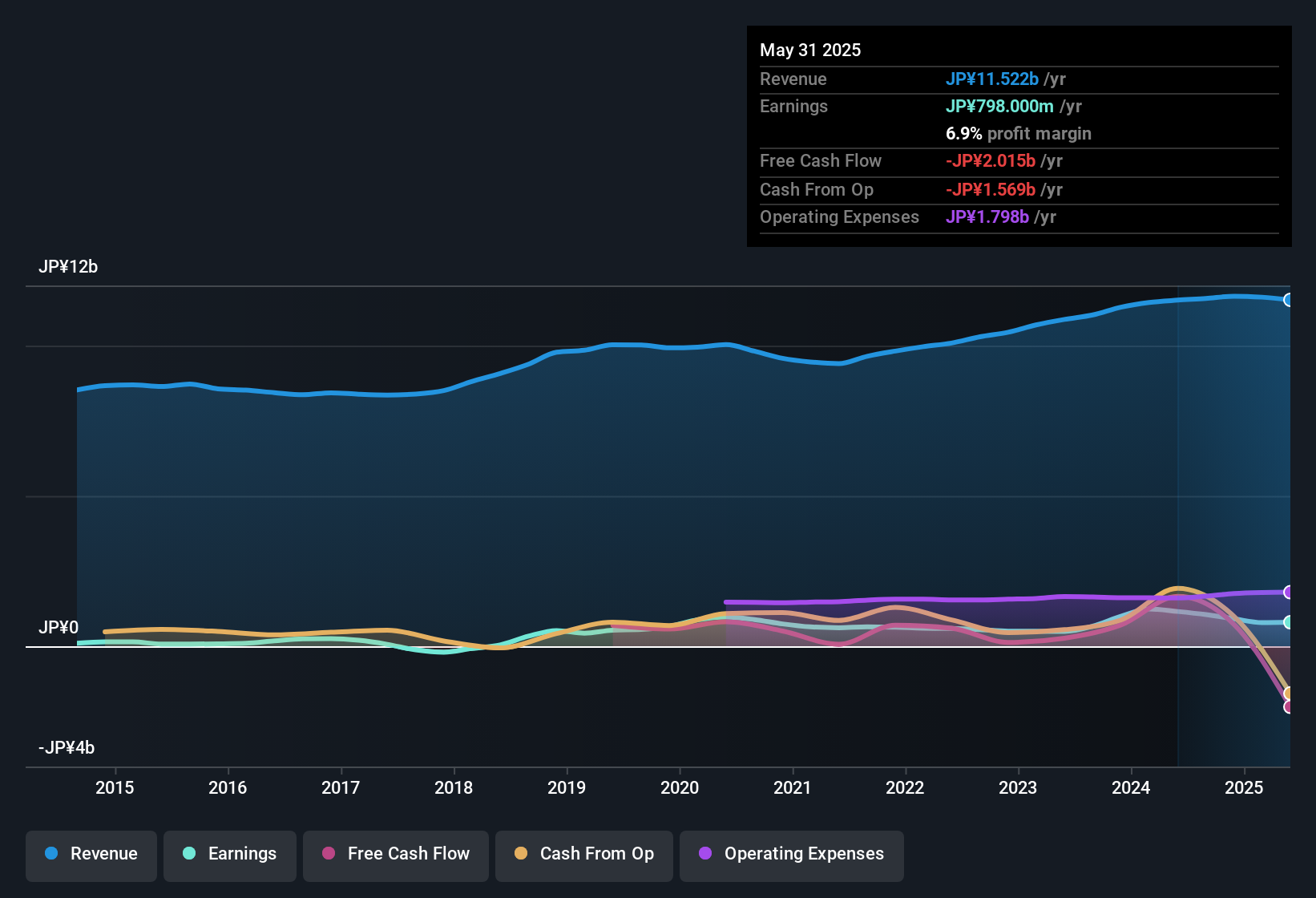Okayama Paper Industries' (TSE:3892) Problems Go Beyond Weak Profit
Last week's earnings announcement from Okayama Paper Industries Co., Ltd. (TSE:3892) was disappointing to investors, with a sluggish profit figure. We did some analysis, and found that there are some reasons to be cautious about the headline numbers.

Examining Cashflow Against Okayama Paper Industries' Earnings
In high finance, the key ratio used to measure how well a company converts reported profits into free cash flow (FCF) is the accrual ratio (from cashflow). To get the accrual ratio we first subtract FCF from profit for a period, and then divide that number by the average operating assets for the period. This ratio tells us how much of a company's profit is not backed by free cashflow.
That means a negative accrual ratio is a good thing, because it shows that the company is bringing in more free cash flow than its profit would suggest. While having an accrual ratio above zero is of little concern, we do think it's worth noting when a company has a relatively high accrual ratio. Notably, there is some academic evidence that suggests that a high accrual ratio is a bad sign for near-term profits, generally speaking.
For the year to May 2025, Okayama Paper Industries had an accrual ratio of 0.40. Statistically speaking, that's a real negative for future earnings. And indeed, during the period the company didn't produce any free cash flow whatsoever. Even though it reported a profit of JP¥798.0m, a look at free cash flow indicates it actually burnt through JP¥2.0b in the last year. It's worth noting that Okayama Paper Industries generated positive FCF of JP¥1.7b a year ago, so at least they've done it in the past. The good news for shareholders is that Okayama Paper Industries' accrual ratio was much better last year, so this year's poor reading might simply be a case of a short term mismatch between profit and FCF. As a result, some shareholders may be looking for stronger cash conversion in the current year.
Note: we always recommend investors check balance sheet strength. Click here to be taken to our balance sheet analysis of Okayama Paper Industries.
Our Take On Okayama Paper Industries' Profit Performance
As we discussed above, we think Okayama Paper Industries' earnings were not supported by free cash flow, which might concern some investors. For this reason, we think that Okayama Paper Industries' statutory profits may be a bad guide to its underlying earnings power, and might give investors an overly positive impression of the company. Nonetheless, it's still worth noting that its earnings per share have grown at 45% over the last three years. The goal of this article has been to assess how well we can rely on the statutory earnings to reflect the company's potential, but there is plenty more to consider. If you'd like to know more about Okayama Paper Industries as a business, it's important to be aware of any risks it's facing. Be aware that Okayama Paper Industries is showing 3 warning signs in our investment analysis and 1 of those is concerning...
This note has only looked at a single factor that sheds light on the nature of Okayama Paper Industries' profit. But there are plenty of other ways to inform your opinion of a company. For example, many people consider a high return on equity as an indication of favorable business economics, while others like to 'follow the money' and search out stocks that insiders are buying. So you may wish to see this free collection of companies boasting high return on equity, or this list of stocks with high insider ownership.
New: AI Stock Screener & Alerts
Our new AI Stock Screener scans the market every day to uncover opportunities.
• Dividend Powerhouses (3%+ Yield)
• Undervalued Small Caps with Insider Buying
• High growth Tech and AI Companies
Or build your own from over 50 metrics.
Have feedback on this article? Concerned about the content? Get in touch with us directly. Alternatively, email editorial-team (at) simplywallst.com.
This article by Simply Wall St is general in nature. We provide commentary based on historical data and analyst forecasts only using an unbiased methodology and our articles are not intended to be financial advice. It does not constitute a recommendation to buy or sell any stock, and does not take account of your objectives, or your financial situation. We aim to bring you long-term focused analysis driven by fundamental data. Note that our analysis may not factor in the latest price-sensitive company announcements or qualitative material. Simply Wall St has no position in any stocks mentioned.
About TSE:3892
Okayama Paper Industries
Engages in manufacture and sale of paper products in Japan and internationally.
Flawless balance sheet with low risk.
Market Insights
Community Narratives




